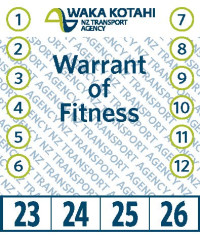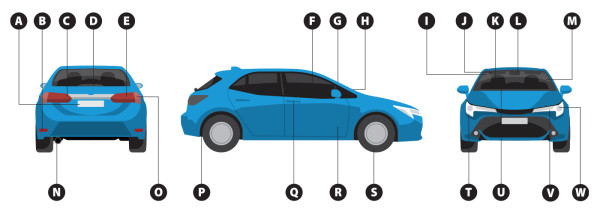Find out what your motor vehicle must have before you can drive or park on the road.
Privately operated cars, utes, vans and 4-wheel drives must have a current WoF. Commercial vehicles and heavy vehicles must have a current certificate of fitness (CoF).
A current WoF shows the vehicle has been inspected by an approved WoF inspector and was roadworthy at the time of the last WoF inspection.
The WoF label must be attached to the inside of the windscreen, on the same side as the steering wheel, and must be clearly visible from outside the vehicle. A good position is the top corner of the windscreen.
As well as a current WoF or CoF, your vehicle must display:

Important!You must keep your vehicle up to WoF standard at all times. You can be fined if you drive any vehicle that isn’t up to WoF standard on a road. A police officer can stop you for a roadside vehicle check at any time. |
To meet the WoF standard, your car must be in good condition, for example, no rust around safety areas, and it must have the following equipment in good working order:

A. A number plate light at the back.
B. 2 red reflectors at the back.
C. 2 red position lights at the back.
D. One or 2 red high-mounted stop lights at the back.
E. 2 or 4 stop lights at the back.
F. A working horn.
G. A windscreen that meets safety standards and is clean.
H. One or more working windscreen wipers.
I. A current WoF.
J. A good sun visor.
K. Safe steering.
L. A rear-view mirror that gives a clear view behind.
M. Working seatbelts.
N. A good silencer and exhaust system.
O. Flashing direction indicator lights at the back.
P. Mudguards.
Q. Doors that open and close safely.
R. Good footbrake and handbrake.
S. Safe tyres – the tread depth must be at least 1.5 millimetres right around the tyre. If your car is fitted with winter tyres, these must be fitted to all 4 road wheels and have a tread depth of at least 4 millimetres right around the tyre.
T. Flashing direction indicator lights at the front.
U. A working speedometer.
V. 2 white or amber position lights at the front.
W. 2 good headlights that can be dipped when another vehicle comes towards you.
Note: this checklist is a guide only. When inspecting your vehicle, the inspector will use the criteria in the Vehicle inspection requirements manual.
Vehicle inspection requirements manual(external link)
Approved seatbelts must be fitted in all light passenger vehicles – cars, vans, utes and 4-wheel drives.
Seatbelts must be in good condition, so you should have seatbelts checked immediately if:
They may need replacing.
Legal requirements for seatbelts have changed over the years and are different depending on the age of the vehicle. The type of belt has also changed from static belts to retractor belts.
Three-point lap and diagonal belts must be fitted in the outer seating positions, including the driver’s seat, in most cars, vans, utes and 4-wheel drives. 2-point, or lap belts, are legally allowed in centre seating positions, but 3-point belts provide better safety.
You must wear your seatbelt when driving. Children must also be belted-in, using approved child restraints.
Seatbelts and child restraints
Important!Before making modifications, including the fitting of extra lights to your vehicle, check with an approved WoF inspector that the modifications are legal. |